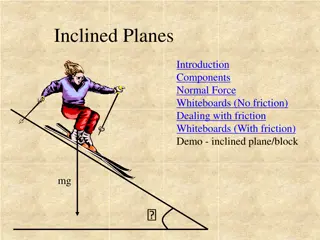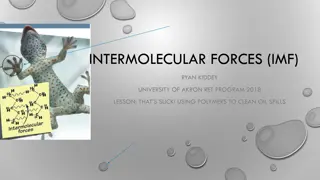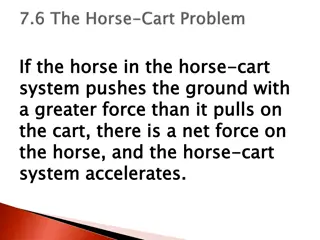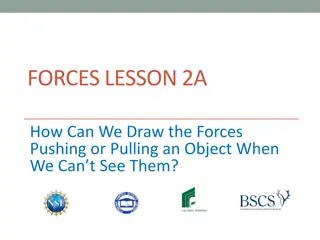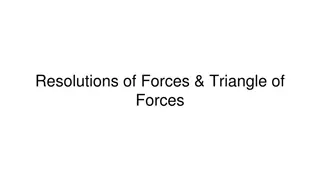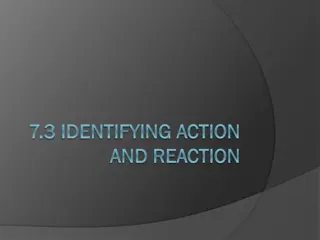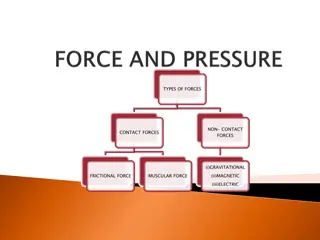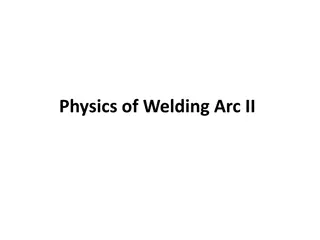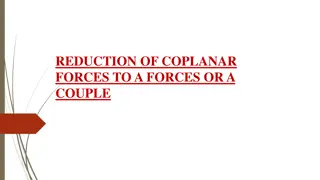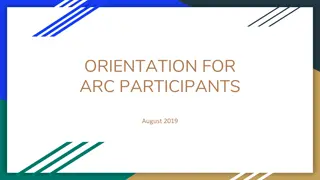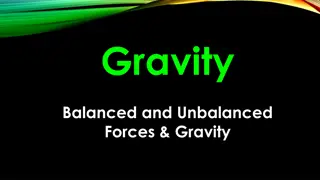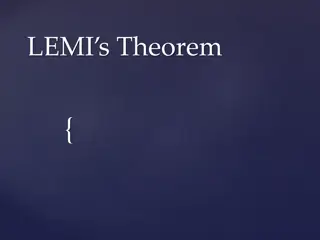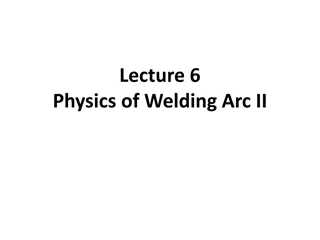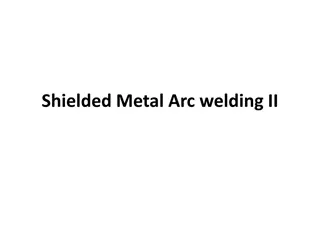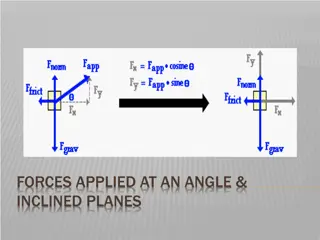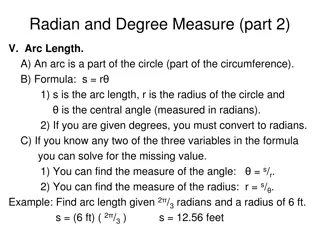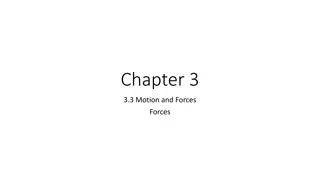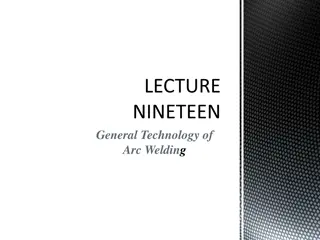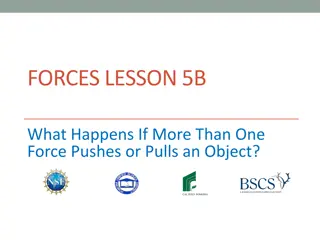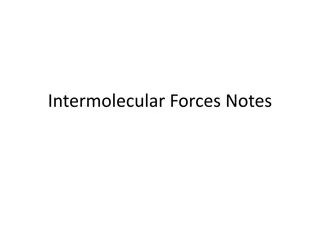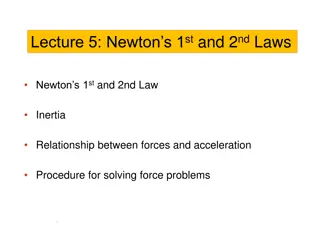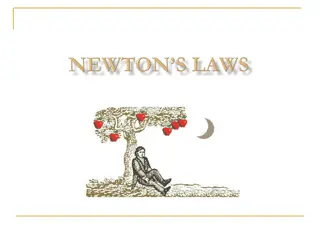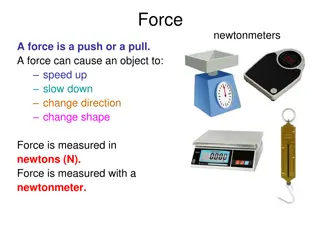Understanding Electric Arc Welding and Its Processes in Metal Joining
Electric arc welding is a vital process for joining metal pieces through the application of heat or pressure. This technique involves the melting of parent metal, and electricity plays a crucial role in generating the required heat. Different welding processes, such as fusion welding and non-fusion
4 views • 21 slides
Understanding Forces and Motion in Physics
Exploring the concepts of forces and motion, this content delves into the fundamental aspects of how forces impact objects' movement. Covering topics such as measuring force, representing force as a vector, combining forces through addition and subtraction, and understanding balanced and unbalanced
2 views • 61 slides
Understanding Inclined Planes and Friction Forces
Introduction to inclined planes, components of forces, dealing with friction on whiteboards, and demonstrations on block forces on inclined planes. Learn about calculating components of gravity, friction forces, and scenarios involving kinetic and static friction on an inclined plane.
3 views • 11 slides
INTERMOLECULAR FORCES (IMF)
Exploring the concepts of intramolecular bonds versus intermolecular forces, the impact of intermolecular forces on states of matter, different types of intermolecular forces, and the significance of dipoles in chemistry. Dive into the world of IMF with visual aids and real-world analogies.
2 views • 12 slides
Understanding the Horse-Cart System: Forces and Acceleration Explained
The Horse-Cart problem delves into the dynamics of forces acting on a horse pulling a cart, highlighting the importance of net forces, accelerations, and external interactions with the ground. The analysis simplifies the complex system by focusing on key forces impacting the cart's movement and the
0 views • 17 slides
Understanding Frictional Forces and Equilibrium Principles in Physics
Explore the concepts of frictional forces and equilibrium in physics with a focus on conditions for forces acting on a body associated with friction. Learn about limiting frictional force, coefficient of friction, and the equilibrium of a body on horizontal and inclined planes. Delve into scenarios
2 views • 9 slides
Understanding Forces: Drawing Invisible Pushes and Pulls
Delve into the concept of forces in science, learning how to draw and represent pushes and pulls even when they are not visible. Explore key ideas about forces, including gravity, and engage in activities to understand how forces cause movement in objects.
1 views • 15 slides
Understanding Resolutions and Triangle of Forces in Physics
Resolutions of forces involve breaking down a force into components, while the Triangle of Forces explores how forces interact in equilibrium. By analyzing graphical and mathematical representations, you can determine the resultant force and its direction using trigonometric functions. Applying the
1 views • 11 slides
Understanding Action and Reaction Forces in Physics
Explore the concept of action and reaction forces in physics through examples like a falling boulder and interactions between different masses. Understand how forces are equal and opposite, leading to accelerations based on mass and force interactions. Discover the relationship between Earth and the
0 views • 16 slides
Understanding Different Types of Forces and Their Applications
This content explores various types of forces including non-contact and contact forces such as gravitational, magnetic, electric, frictional, and muscular forces. It also discusses the effects of forces on different surfaces and provides examples of force application in real-life scenarios.
1 views • 10 slides
Understanding Arc Forces in Welding: Gravity and Surface Tension Forces
Explore the significance of arc forces in welding, focusing on gravity and surface tension forces. Learn how these forces impact metal transfer, deposition efficiency, and welding quality. Discover the role of gravitational force in detachment and transfer of molten metal, and how surface tension fo
4 views • 25 slides
Understanding Coplanar Forces and their Classification
Coplanar forces are forces that lie in the same plane and can be classified into concurrent, parallel, non-concurrent, and non-parallel systems. These forces can be reduced to a single force or a couple for analysis. Understanding these force systems is essential in engineering and physics to determ
2 views • 20 slides
ARC Mentorship Program Overview
The AfriWon Research Collaborative (ARC) offers a pilot program to provide mentorship for family physicians in sub-Saharan Africa. The program aims to support participants in developing research protocols through online modules and mentorship relationships. Participants will gain an understanding of
1 views • 19 slides
Understanding Central and Non-Central Forces in Physics
Newton's laws of motion introduced the concept of forces, leading to the classification of fundamental forces like gravitational, electromagnetic, strong nuclear, and weak nuclear forces. Central forces act toward or away from a fixed center, while non-central forces are affected by additional param
0 views • 7 slides
Understanding Van der Waals Forces and Intermolecular Interactions
Van der Waals forces encompass London dispersion forces, dipole-dipole forces, and hydrogen bonding, influencing interactions between atoms and molecules. London dispersion forces are the weakest and present in all molecules, dipole-dipole forces involve permanent dipoles, and hydrogen bonding, the
0 views • 9 slides
Understanding Forces in Physics
Explore the concept of forces in physics, including definitions, measurement units, combining forces, and their effects on objects' motion. Learn about balanced and unbalanced forces, net force, force pairs, directions, magnitude, and how to combine forces at right angles. Develop a solid understand
0 views • 24 slides
Understanding Gravity and Balanced/Unbalanced Forces in Physics
Explore the fundamental concepts of gravity and balanced/unbalanced forces in physics. Gravity is the force that pulls objects toward each other, acting universally. Balanced forces maintain object stability, while unbalanced forces can cause motion changes based on direction, strength, and mass. Di
0 views • 9 slides
Understanding Forces in Mechanics: Fundamentals and Applications
Prof. Madhuri Reddy, an Assistant Professor at Hope Foundation's International Institute of Information Technology, explains the characteristics of forces, systems of forces, and the concept of resultant force and composition of forces in mechanics. Forces are defined as agents that produce or destr
0 views • 11 slides
Understanding Lami's Theorem in Physics
Lami's Theorem is an equation that explains how the magnitudes of forces acting on a point keep an object in equilibrium. This theorem relates the forces with corresponding angles and is derived by understanding the sum of forces acting on a point. By utilizing complementary angles and the sine rule
0 views • 8 slides
Methods of Welding Arc Initiation and Maintenance
This lecture delves into the methods used to initiate and maintain the welding arc, including touch start and field start techniques. It explores the characteristics of the welding arc, temperature distribution, and factors influencing arc behavior. Touch start involves creating a small gap by bring
3 views • 16 slides
Welding Current Selection and Electrode Factors in Shielded Metal Arc Welding
When selecting the welding current for Shielded Metal Arc Welding (SMAW), considerations such as plate thickness, cable length, arc initiation ease, arc blow, and welding position play crucial roles. Direct Current (DC) is preferred for thin sheets and odd position welding, while Alternating Current
0 views • 10 slides
Understanding Forces Applied at an Angle on Inclined Planes
Exploring the concept of forces applied at angles other than 90 degrees on inclined planes, the process involves resolving forces into component vectors, finding net forces in each direction, writing force equations (Fnet = ma), and solving for normal force and acceleration in practical scenarios li
0 views • 28 slides
Understanding Radian and Degree Measure for Arc Length and Area of a Sector
Exploring radians and degrees in relation to arc length, sector area of a circle, and converting measurements between degrees and radians. Learn how to find arc length and sector area given central angles and radii, as well as convert degrees to minutes and seconds or vice versa.
1 views • 4 slides
Understanding Radians: Measurement, Arc Length, Sectors, and Trigonometry Equations
This content covers various topics related to radians, including radian measurement, arc length, areas of sectors and segments, and solving trigonometric equations. It also includes small angle approximations and worked examples on converting angles to radians and degrees, sketching graphs, finding
0 views • 40 slides
Understanding Forces in Motion: A Comprehensive Overview
Forces play a crucial role in our daily activities, influencing motion and direction. This chapter delves into the concept of forces as pushes or pulls, exploring balanced and unbalanced forces and their impact on velocity. By examining real-life scenarios like kicking a soccer ball or opening a doo
0 views • 10 slides
Gas Metal Arc Welding (GMAW) Equipment and Functionality Overview
Gas Metal Arc Welding (GMAW) is a versatile welding process that utilizes a consumable electrode wire, electric arc, and shielding gas to join metallic materials efficiently. This method requires essential equipment like power source, consumable electrode wire, wire feeder, welding gun, shielding ga
0 views • 10 slides
Understanding Balanced and Unbalanced Forces in Physics
Forces play a crucial role in determining an object's motion. Balanced forces have a net force of 0 N, resulting in no change in motion, while unbalanced forces lead to a change in motion. Inertia, the resistance to changes in motion, and the concept of combining forces are also important in underst
2 views • 30 slides
Understanding Forces and Mass
Forces, such as contact and non-contact forces, interact with objects to cause motion or deformation. Mass is the amount of matter in an object, measured in kilograms. Learn about applied force, normal force, frictional force, air resistance, spring force, tensile forces, compressive forces, and she
1 views • 29 slides
Understanding ARC: Attachment, Regulation, and Competency in Trauma Care
Explore the world of ARC (Attachment, Regulation, and Competency) in trauma care, a framework designed for working with children and teens affected by trauma. Learn about the core principles of ARC, its focus on strengthening relationships, enhancing self-regulation, and building resilience. Discove
0 views • 20 slides
Understanding Force Diagrams and Balanced/Unbalanced Forces
Explore the concepts of force diagrams, balanced forces, and unbalanced forces through visual examples and explanations. Learn how balanced forces keep objects stationary or at a constant speed, while unbalanced forces cause movement and changes in direction. Practice calculating resultant forces an
1 views • 11 slides
Essential Information on Arc Welding Technology
Arc welding is a fusion process utilizing an electric arc to melt metals for joining. Consumable and nonconsumable electrodes play key roles, providing filler metal and resisting arc heat respectively. Arc shielding using gases or flux prevents metal contamination. Understanding these fundamental co
0 views • 8 slides
Understanding Forces: Effects of Multiple Forces on Objects
Exploring the impact of multiple forces on objects through scenarios involving friction, pushing, and pulling. Students investigate the role of gravity and analyze how different forces influence the movement or stability of objects. The lesson includes hands-on activities and discussions to deepen u
0 views • 10 slides
Understanding Intermolecular Forces: Strength, Types, and Examples
Intermolecular forces are attractions between molecules, weaker than chemical bonds. They include London dispersion forces, dipole-dipole interactions, and hydrogen bonding. Strength varies, with covalent bonds being the strongest and London dispersion forces the weakest. Different types of intermol
0 views • 15 slides
Understanding ARC Rejoinder Process in Peer Review: A Comprehensive Overview
The ARC Rejoinder Information Session provides insights into the Peer Review Process of the Australian Research Council (ARC). It explains the role of Assessors, the importance of Rejoinders, and the overall criteria for funding decisions under the National Competitive Grants Program (NCGP).
0 views • 55 slides
Understanding Intermolecular Forces and Dispersion Forces in Molecules
Particle diagrams of liquids, solids, and gases reflect distinct arrangements due to intermolecular forces. The existence of substances as gases, liquids, or solids at room temperature is attributed to the forces between molecules known as intermolecular forces (IMF), with dispersion forces being th
0 views • 30 slides
Understanding ARC Reflections: A Framework for Trauma-Informed Care
Explore the ARC framework, Attachment, Regulation, and Competency, developed for working with children and teens who have experienced trauma. Learn about the ARC-informed caregiver training curriculum, warm-up activities, opening check-ins, and strategies to support a child's sense of self and ident
0 views • 54 slides
Understanding the Hazards of Arc Flash Incidents by Littelfuse Startco
Littelfuse Startco highlights the dangers of arc flash incidents, emphasizing the costly and dangerous consequences such as fires, burns, injuries, and even fatalities. The case study of an electrician's severe burns serves as a stark reminder of the potential risks associated with electrical hazard
0 views • 24 slides
Understanding Newton's Laws of Motion: Inertia, Forces, and Acceleration
Delve into the fundamentals of Newton's first and second laws of motion, exploring concepts such as inertia, the relationship between forces and acceleration, and the procedure for solving force problems. Discover how objects behave when left to themselves, and grasp the significance of forces in ch
0 views • 21 slides
Understanding Forces and Equilibrium in Physics
Forces in physics can be categorized into contact forces and field forces, measured in units like Newtons (N). Inertia, mass, weight, and equilibrium are fundamental concepts in understanding the behavior of objects under different conditions. An object in motion stays in motion unless acted upon by
0 views • 15 slides
Understanding Forces and Their Applications
Forces are pushes or pulls that can cause objects to speed up, slow down, change direction, or shape. They are measured in newtons (N) using a newtonmeter. Various types of forces include contact, tension, electrostatic, friction, and gravitational forces. Forces always occur in pairs, with equal an
0 views • 46 slides


